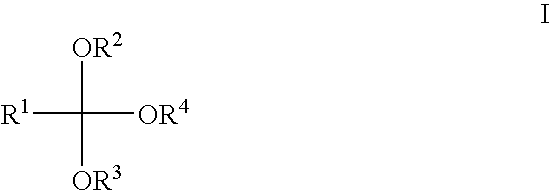Method for producing orthocarbonic acid trialkyl esters
- Summary
- Abstract
- Description
- Claims
- Application Information
AI Technical Summary
Benefits of technology
Problems solved by technology
Method used
Image
Examples
example 1
[0068]A non-compartmentalized cell with graphite electrodes in a bipolar arrangement was used. The total electrode surface area was 0.145 m2 (anode and cathode). The electrolyte used was a solution consisting of 2 mol of methanol to 1 mol of TME and containing 2% by weight of MTBS as the conducting salt. Electrolysis was carried out at 300 A / m2 and a charge quantity of 2 F, based on TME, was passed through the cell. The electrolysis temperature was 20° C. When the electrolysis had ended, the products were determined quantitatively by gas chromatography and qualitatively by GC coupled with MS. TMOF was formed with a selectivity of 77% for a TME conversion of 69%. The principal by-products were methyl formate and methylal.
example 2
[0069]240.3 g of 1,1,2-trimethoxyethane, 320 g of methanol and 5.8 g of ammonium tetrafluoroborate were placed in an electrolysis cell with an electrode surface area of 316.4 cm2, but otherwise as described in Example 1, and subjected to electrolysis. The electrolysis conditions were as described in Example 1. The electrolysis products contained 9.5 GC area % of formaldehyde dimethylacetal and 5.9 GC area % of trimethyl orthoformate.
example 3
[0070]89 g of 2,2,3,3-tetramethoxybutene (80% pure, prepared from diacetyl and trimethyl orthoformate), 64 g of methanol and 1.7 g of ammonium tetrafluoroborate were reacted in an electrolysis cell with an electrode surface area of 298.8 cm2, but otherwise as described in Example 1. The electrolysis conditions were as described in Example 1. The electrolysis products contained 1.7 GC area % of trimethyl orthoacetate for a current quantity of 2 Faraday and 18 GC area % for a current quantity of 8 F.
PUM
| Property | Measurement | Unit |
|---|---|---|
| Temperature | aaaaa | aaaaa |
| Temperature | aaaaa | aaaaa |
| Capacitance | aaaaa | aaaaa |
Abstract
Description
Claims
Application Information
 Login to View More
Login to View More - R&D
- Intellectual Property
- Life Sciences
- Materials
- Tech Scout
- Unparalleled Data Quality
- Higher Quality Content
- 60% Fewer Hallucinations
Browse by: Latest US Patents, China's latest patents, Technical Efficacy Thesaurus, Application Domain, Technology Topic, Popular Technical Reports.
© 2025 PatSnap. All rights reserved.Legal|Privacy policy|Modern Slavery Act Transparency Statement|Sitemap|About US| Contact US: help@patsnap.com



